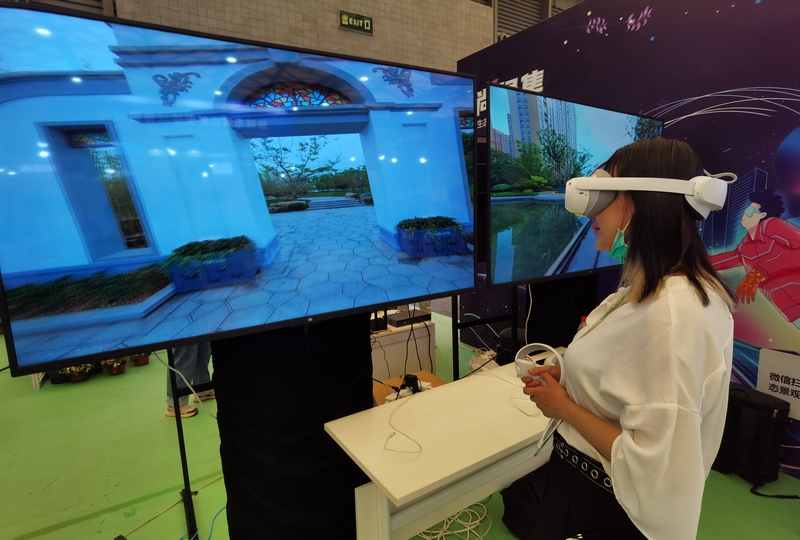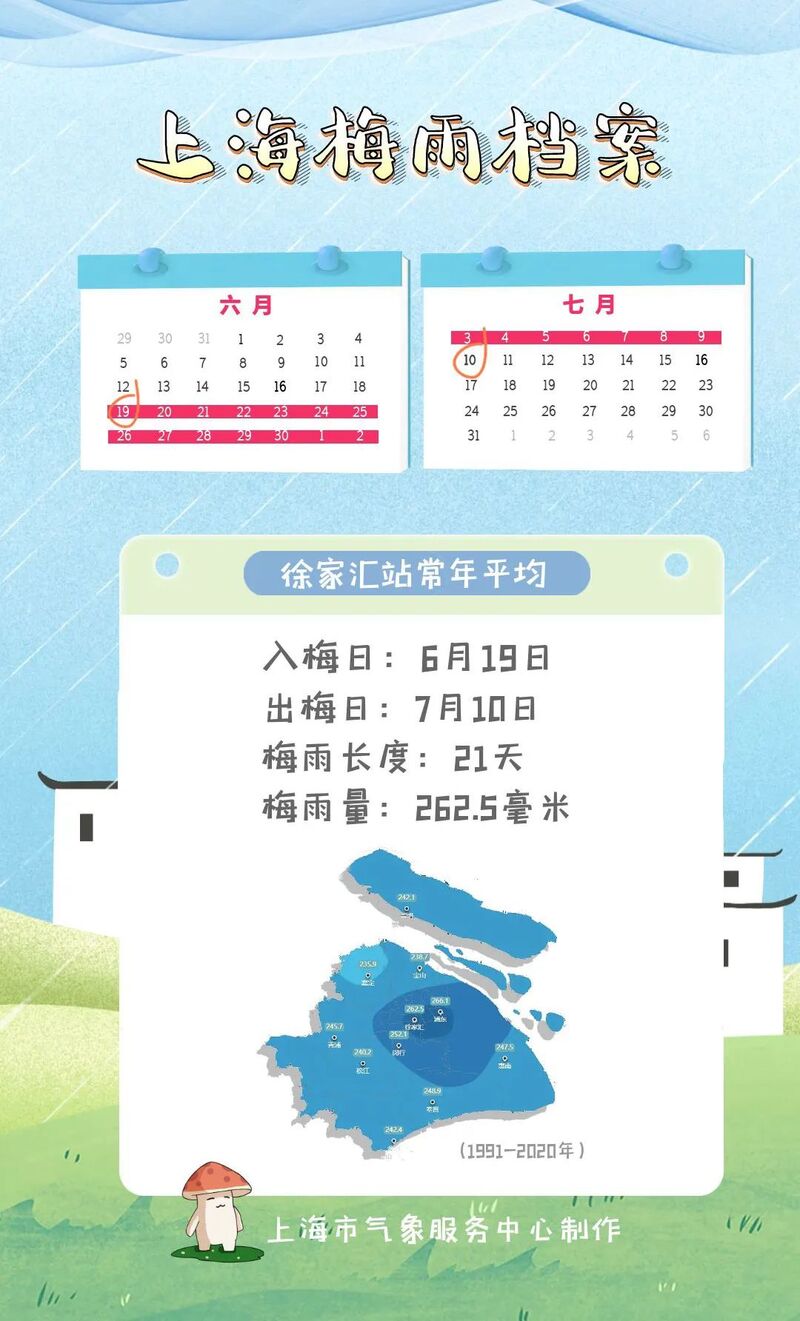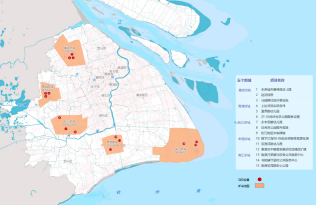Biodiversity conservation and park experience can be balanced, with 8 Shanghai "natives" settling down in the park
Returning "indigenous" wildlife to the places where their ancestors once thrived is professionally called "reintroduction": rebuilding a population of a species within a portion of its historical distribution area.
On September 7th, the "reintroduction" project in Shanghai made new progress, with 8 adult deer being released into the wild in the Shanghai Binjiang Forest Park to supplement the original population in the area.
How to put it?
Looking back two and a half hours, the 8 deer that met the conditions for wild release were packed in Huaxia Park. They lay in a dedicated turnover box and looked out through the ventilation holes on the box, feeling very nervous.
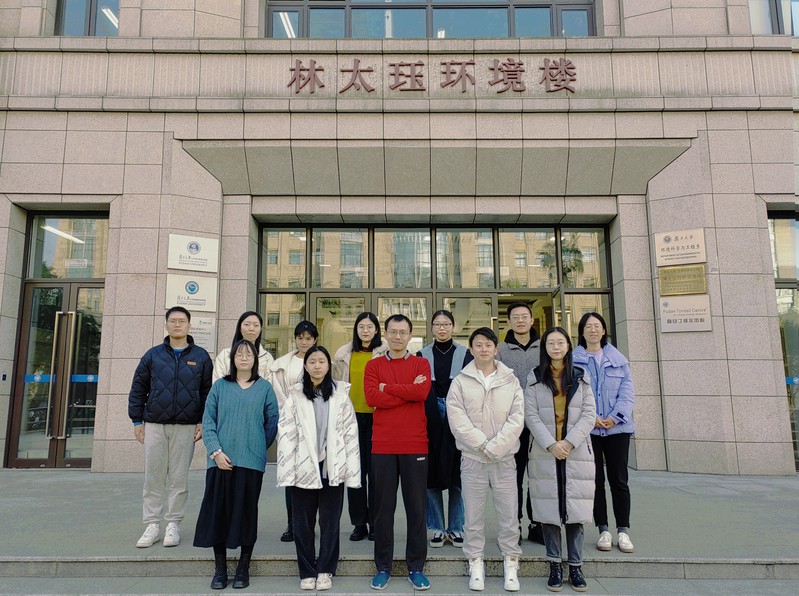
Nie Dayi, a Ph.D. in Conservation Biology from the School of Life Sciences at East China Normal University, is also very nervous: "Zhang is very timid. Even a slight mistake in the seemingly easy 'moving' can trigger their intense stress response, and in severe cases, it can cause shock or even death."
Body temperature is an important reference for evaluating the degree of stress, and animals may experience elevated blood pressure and body temperature under stress. Nie Dayi introduced that the body temperature of several deer once exceeded 42 ℃, usually not exceeding 40 ℃ under normal circumstances. They should be immediately placed in a secluded area with air conditioning to reduce unnecessary human interference.
Jiefang Daily's Shangguan News reporter learned that if the stress response is too strong and persistent, such deer cannot be released in the wild. After health monitoring, deer with parasites or diseases cannot receive a "return home" ticket.
The staff moved Zhang to a wild release point and Chen Xi shook the camera

Waiting for the wild release of Gongzhang Chen Xi to take a stunning photo
"This is the first time we have tried the wild release of deer in such a hot outdoor environment. We are afraid that they will not be able to withstand it, so we have advanced the planned time by half an hour. The relevant inspections and preparation work have been arranged in a cool morning." Nie Dayi said, controlling the entire process from the deer entering the turnover box to the wild release within 3 hours to prevent excessive time and more uncontrollable factors.
At one o'clock in the afternoon, the staff lifted one side of the box, and the last deer bounced out from the exit on the other side, running happily towards the distant bushes. According to the introduction, 8 headed deer, 4 males and 4 females can freely pair up in the park if they like each other, or search for descendants of the deer that were previously released in the park. Recently, two wild deer will be released to Shanghai Binjiang Forest Park.
The reporter noticed that all 8 deer were wearing electronic collars, which can track their activity trajectory, activity level, and other information. If very inactive and suspected of encountering danger or health issues, the research team's staff will go to the site to inspect based on Zhang's latest positioning.

In addition, there are 4 infrared trigger cameras in the park, along with 6 infrared trigger cameras to be added by the research team of the School of Life Sciences at East China Normal University, forming an "invisible" monitoring network to capture images of deer activities and better protect them.
Zhang, wearing a collar, temporarily stuck in the box and didn't leave. Chen Xi shook the camera
After being released from the wild, the deer darted everywhere. Chen Xi shook the camera
During the wild release process, Chen Xi shook the camera

Why put it on?
Swertia, also known as Swertia, Swertia, Swertia, and muntjac, is a small deer family wild animal. It often chooses the riverbank, lakeside, grass beach in the center of the lake, beach reed or grass overgrown environment as its daily habitat, and also lives in low hills and island forest edge grass thickets. In history, it was widely distributed in the Liaodong Peninsula, North China Plain, both sides of the Yangtze River, and the Korean Peninsula.
The deer, which is currently a national second level protected animal, is an "indigenous" species in Shanghai. According to fossil excavations and literature records, as early as the Neolithic period, there were deer distributed in the Shanghai area, and the deer teeth are found in the fossils of the Songze site.
In the 1880s, there were still many deer living in the suburbs of Shanghai, Qingpu, Fengxian, and other areas. Farmers in the suburbs once brought deer and wild chickens to the city for sale. With the increase in population density and socio-economic development, the forest land suitable for deer to live in has gradually shrunk. Coupled with high-intensity hunting, they disappeared from Shanghai in the early 20th century.

More than 100 years later, the disappearance of "natives" such as Zhang has put Shanghai in an awkward situation of not having wild large mammals. At that time, water deer were distributed in the Zhoushan Islands of Zhejiang, the Poyang Lake area of Jiangxi, the coastal wetlands of Jiangsu, and Anhui. Many knowledgeable people proposed to reintroduce water deer and establish self-sustaining wild populations in Shanghai, becoming the flagship species for urban ecological restoration in Shanghai.
However, when reintroducing the water deer, the purity of its bloodline is particularly crucial, which is to find a species that is completely identical to the local water deer in Shanghai.
Professor Chen Min from the School of Life Sciences at East China Normal University and his classmates went to several habitats to investigate and collected samples of water deer's hair, feces, etc. Through gene comparison, it was determined that the genetic diversity of various populations of water deer in China still belongs to intra species differences and has not differentiated.
The doubts about "bloodline" have been cleared, and the reintroduction of the Zhang project has begun to accelerate comprehensively. In 2007, the deer began their journey back to their hometowns. The Shanghai forestry department introduced 21 adult deer from Zhoushan, Zhejiang, and created a forest area of over 5000 square meters with water systems and rich vegetation in the Pudong section of the outer ring forest belt, allowing them to adapt to the natural conditions of Shanghai's climate and ultimately reproduce successfully.
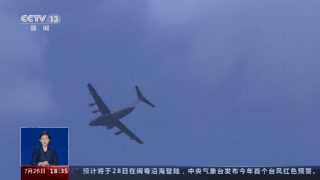
According to the data released by the Shanghai Forestry Station, since the introduction of Zhang, through population breeding and wild training, as of the end of last year, Shanghai has released 315 Zhang from Huaxia Park in the wild in Binjiang Forest Park, Songjiang Punan Forest, Chongming Pearl Lake Park, Nanhui Dongtan, Pudong Old Port Coastal Ecological Corridor and other places.
The vast majority of wild released water deer in Shanghai come from places such as Huaxia Park, Songjiang Yexie water deer minimal population recovery and wild release bases, and Songjiang Xinbang water deer population expansion points. As of last year, Huaxia Park has bred nearly 400 deer in total; After the introduction of 50 deer from 2008 to 2009, the restoration and wild release base of the extremely small population of the Songjiang Yexie deer has cumulatively expanded the breeding of 200 deer as of March last year.
At present, Shanghai has basically achieved self-sufficiency in the entire process of deer breeding from population to wild release.
Zhang's "Home" in Shanghai, Shocked by Chen Xi
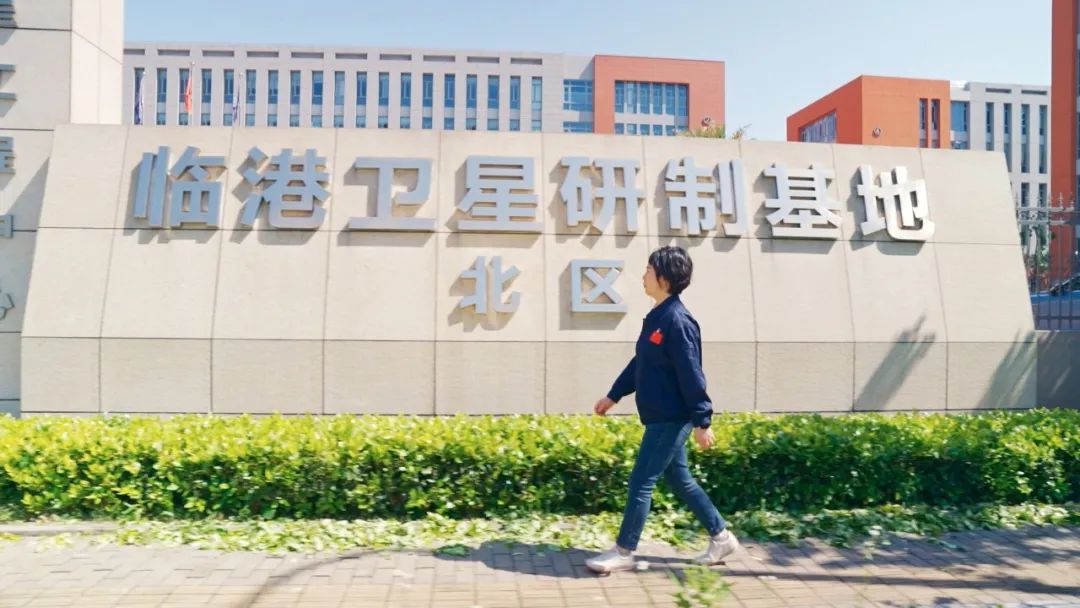
The restoration and wild release base of the extremely small population of Songjiang Yexie Zhang, Zhang discovered someone and prepared to leave. Photo by Li Maojun
How to deal with it?
Shanghai Binjiang Forest Park is one of the earliest parks in Shanghai to pilot the wild release of deer. Since deer are very timid animals, how to balance the needs of wildlife protection and tourist recreation in parks with high foot traffic?
Shanghai Binjiang Forest Park is located at the northernmost end of Pudong New Area and is the suburban forest park with the highest forest coverage in Shanghai, which creates good conditions for the settlement of wild deer.

In November 2009, 12 deer were transported from the source base of Huaxia Park and became the earliest "indigenous residents" here. In January of the following year, 2 more were added. In the following years, the population of deer in the park remained at around 30, and senior employees even reported that at its peak, about 50 deer appeared in the park.
But in recent years, the number of deer in Shanghai Binjiang Forest Park seems to have decreased. The monthly report on monitoring terrestrial wildlife resources in Shanghai in July this year showed that only 5 instances of deer were recorded in the Binjiang Forest Park for a total of 31 days. Although limited monitoring equipment is the main reason for fewer records, it can also reflect to some extent the low activity of deer.
"It feels like it's missing," Zhang Guobing, deputy director of Shanghai Binjiang Forest Park, told reporters. In 2019, he met Zhang Zhang about once a week, but by July 2021, he only met her once a month.
Shanghai Binjiang Forest Park, encountering a roe deer, the roe deer spotted the photographer and was too scared to walk. After staying for a while, the roe deer immediately fled to the park for a photo
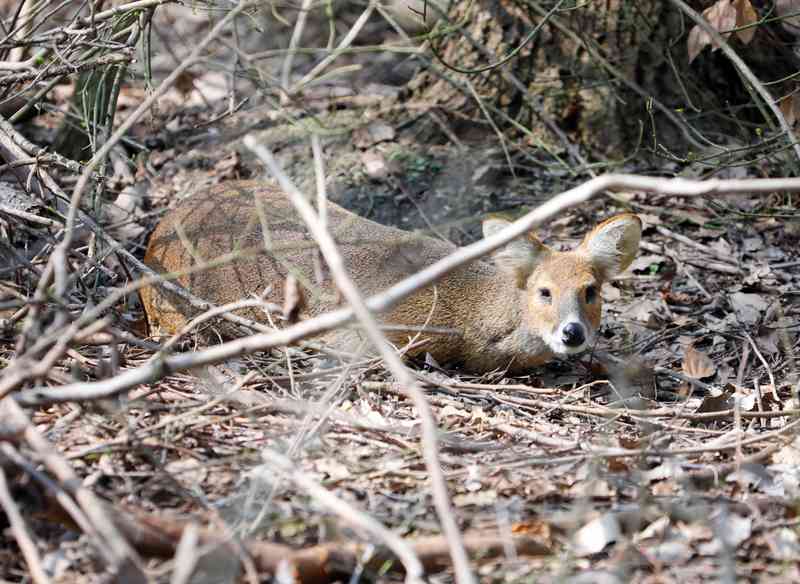
Wild release is different from captive breeding. Nature is cruel, and the deer itself is a relatively fragile species, naturally timid. "Many animals smaller than it can intimidate it and then kill it," Zhang Guobing said. The park analyzed the situation of the deer's decline and believed that the invasion of wild dogs in the surrounding area and the significant increase in passenger flow after the free opening of the park in July 2021 had an impact on the deer.
"Before this wild release, the park and local public security worked together to clean up the wild dogs in the park." Zhang Guobing said that after solving the biggest threat, the park shifted its attention to tourists and adjusted some roads leading to the main activity areas of the deer. For example, the area near the city expressway in the park did not have park roads built, only maintenance roads were built, or some roadblocks were set up to prevent tourists from disturbing the deer after entering.
After the external threats are resolved, it is also necessary to further optimize Zhang's home.
A study published by Chen Min et al. in 2016 on wild release of water deer in Shanghai Binjiang Forest Park found that the released water deer tended to choose habitats with mainly wild grasslands, moderate tree and shrub densities, tree heights ranging from 10 to 15 meters, and herbaceous plant heights not less than 30 centimeters, avoiding habitats with herbaceous plant heights below 5 centimeters or without herbaceous plant distribution.

Under the guidance of experts, Shanghai Binjiang Forest Park is further enriching the forest structure. It has been found that water deer prefer to eat the tender buds of plants such as purple sepals and February orchids. Therefore, the planting area of these plants under the forest has been increased, and the use of pesticides has been reduced; For example, Zhang likes to live in places with water sources and hidden resting places. The park facilitates the excavation of multiple small pools under the forest, and recycles the dead branches and leaves generated by forest maintenance and greening, creating multiple "shelters".
In winter, the deer may face a shortage of food sources, and the park also places feed in their main foraging areas based on their activity trajectory, and plants some vegetation with strong overwintering ability.
Photo by Zhang Li Maojun, who is alert to the surrounding situation in the shelter
Experts say that the ultimate goal of Zhang's "return home" is to establish a self-sustaining wild population in Shanghai, become the flagship species for urban ecological restoration, promote the restoration of Shanghai's natural ecosystem, and fill the gap in urban ecological construction in this regard.
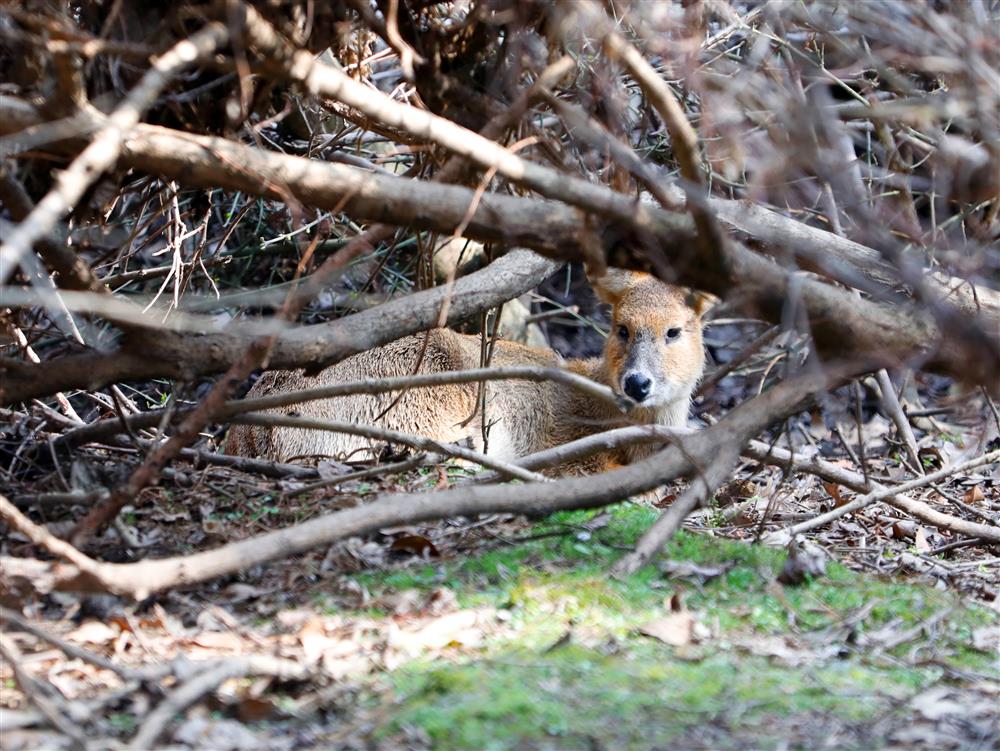
"The recovery of a species may take decades or even hundreds of years." Chen Min said that although there are currently deer populations in the wild, the scale still lags behind the ideal state. From a biological perspective, it is generally believed that for small deer like deer, there must be at least 500 breeding populations, with a total of about 1000, in order to basically meet the standards for population recovery.
For indigenous people like Zhang who have returned and are striving to expand their population, how to prevent hunting or disturbance, and maintain the ecological land properties unchanged, can provide basic conditions for their long-term reproduction.
At this point, the concept of harmonious coexistence between humans and nature has been integrated into the planning and design of ecological projects such as the urban ecological park belt and the "City of Thousand Gardens", leaving a blank space for the reproduction and reproduction of wildlife, or actively creating suitable habitats to attract birds and animals to settle down. It can be said that this precious green development opportunity cannot be missed again.
